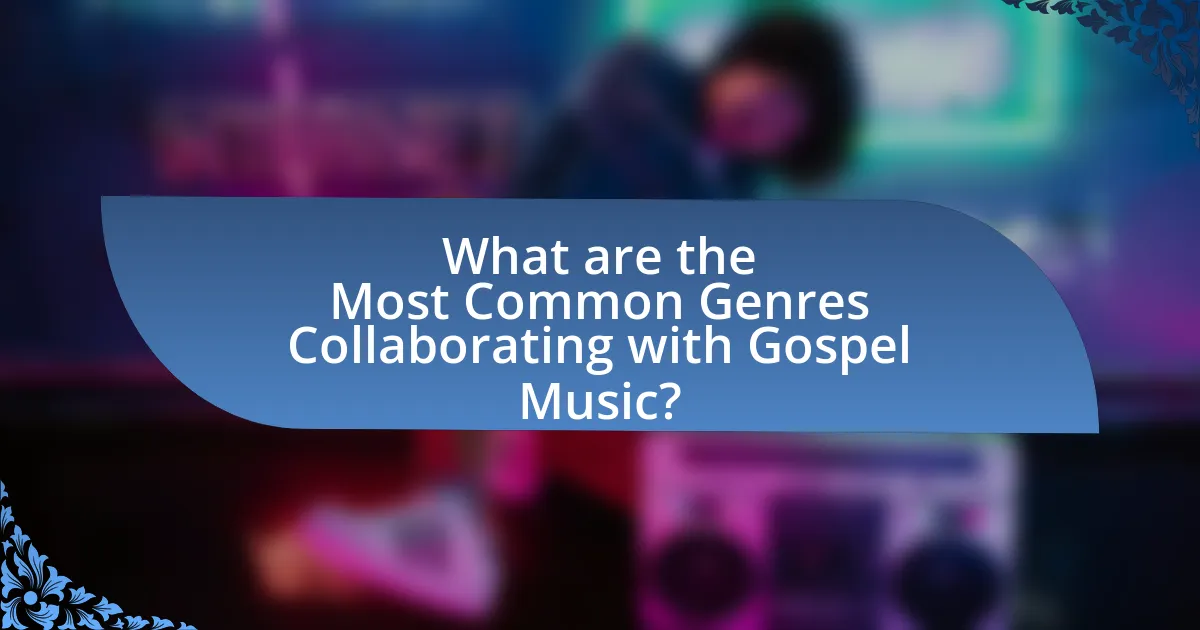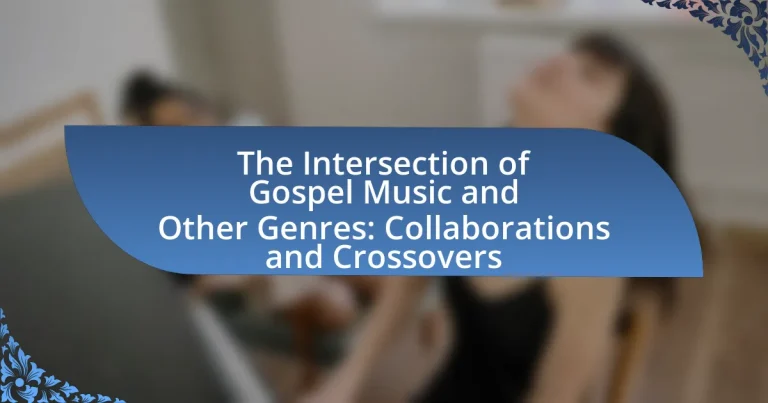The article explores the intersection of gospel music with various genres, highlighting the significance of collaborations and crossovers that blend spiritual themes with diverse musical styles. It examines how gospel music has evolved by incorporating elements from R&B, hip-hop, and rock, influenced by historical events such as the Great Migration and the Civil Rights Movement. The piece also discusses the impact of these collaborations on the perception of gospel music in mainstream culture, the challenges artists face, and best practices for maintaining authenticity while engaging in cross-genre partnerships. Key artists and notable collaborations are identified, showcasing the genre’s versatility and broad appeal.

What is the Intersection of Gospel Music and Other Genres?
The intersection of gospel music and other genres occurs through collaborations and crossovers that blend spiritual themes with diverse musical styles. For instance, gospel has significantly influenced genres like R&B, hip-hop, and rock, with artists such as Aretha Franklin and Kirk Franklin merging gospel elements into their music. This fusion is evident in the use of gospel choirs in pop songs and the incorporation of gospel rhythms and melodies in contemporary music, showcasing the genre’s versatility and broad appeal. The Grammy Awards often recognize these cross-genre collaborations, highlighting the impact of gospel music on the wider music industry.
How has Gospel Music evolved to incorporate other genres?
Gospel music has evolved to incorporate other genres through collaborations and stylistic fusions, reflecting cultural shifts and broader musical trends. For instance, the emergence of gospel-infused hip-hop in the 1990s, exemplified by artists like Kirk Franklin, showcased how traditional gospel themes could blend with contemporary rhythms and beats. Additionally, the incorporation of elements from R&B, jazz, and rock has led to a more diverse sound, as seen in the works of artists such as Aretha Franklin and Mahalia Jackson, who integrated secular styles while maintaining gospel’s spiritual essence. This evolution is further evidenced by the rise of contemporary Christian music, which often borrows from pop and rock, making gospel more accessible to wider audiences.
What historical events influenced the blending of Gospel Music with other styles?
The blending of Gospel Music with other styles was significantly influenced by the Great Migration, which occurred from 1916 to 1970, as African Americans moved from the rural South to urban centers in the North. This migration led to the emergence of new musical forms, such as Rhythm and Blues and Soul, which incorporated Gospel elements. Additionally, the Civil Rights Movement of the 1950s and 1960s played a crucial role, as Gospel music became a soundtrack for social change, merging with genres like Rock and Pop to amplify messages of hope and resistance. The integration of Gospel into these styles was further facilitated by the rise of radio and television, which allowed for broader dissemination and cross-pollination of musical influences.
How do cultural shifts impact the evolution of Gospel Music?
Cultural shifts significantly impact the evolution of Gospel Music by influencing its themes, styles, and collaborations with other genres. For instance, the Civil Rights Movement in the 1960s led to the incorporation of social justice themes in Gospel songs, reflecting the struggles and aspirations of the African American community. Additionally, the rise of contemporary Christian music in the late 20th century introduced elements of pop, rock, and hip-hop into Gospel, broadening its appeal and reach. This blending of genres has resulted in successful collaborations, such as those between Gospel artists and mainstream musicians, which further evolve the sound and message of Gospel Music. The adaptation of Gospel to fit modern cultural contexts demonstrates its resilience and relevance, ensuring its continued evolution.
Why are collaborations between Gospel and other genres significant?
Collaborations between Gospel and other genres are significant because they expand the reach and influence of Gospel music, allowing it to resonate with diverse audiences. These collaborations often blend musical styles, creating innovative sounds that attract listeners who may not typically engage with Gospel. For instance, the collaboration between Kirk Franklin and artists from hip-hop and R&B has led to chart-topping hits, demonstrating how Gospel can thrive in mainstream music. This fusion not only enhances the visibility of Gospel artists but also promotes cultural exchange, fostering a greater appreciation for the spiritual messages inherent in Gospel music across various demographics.
What role do collaborations play in expanding the reach of Gospel Music?
Collaborations play a crucial role in expanding the reach of Gospel Music by blending it with other genres, thereby attracting diverse audiences. When Gospel artists collaborate with musicians from pop, hip-hop, or R&B, they introduce their music to fans who may not typically engage with Gospel, significantly broadening its listener base. For instance, the collaboration between Kirk Franklin and Lil’ Baby on the song “We Win” showcases how merging styles can create a crossover appeal, leading to increased streaming and chart performance. This strategic blending not only enhances visibility but also fosters cultural exchange, allowing Gospel Music to resonate in various social contexts and communities.
How do these collaborations affect the perception of Gospel Music in mainstream culture?
Collaborations between Gospel music artists and mainstream musicians enhance the perception of Gospel music by broadening its audience and integrating it into popular culture. These partnerships often lead to increased visibility for Gospel music, as seen in collaborations like Chance the Rapper’s work with Gospel artists, which garnered significant attention and won Grammy Awards. Such cross-genre collaborations not only validate Gospel music within the broader music industry but also introduce its themes of faith and spirituality to diverse listeners, thereby reshaping its cultural significance.

What are the Most Common Genres Collaborating with Gospel Music?
The most common genres collaborating with gospel music are R&B, hip-hop, and pop. R&B artists often incorporate gospel elements into their music, as seen in the works of artists like Aretha Franklin and Alicia Keys, who blend soulful melodies with spiritual themes. Hip-hop frequently samples gospel music, with artists such as Kanye West and Chance the Rapper using gospel choirs and themes to enhance their tracks. Additionally, pop music has seen collaborations with gospel, exemplified by artists like Justin Bieber and Katy Perry, who have featured gospel influences in their songs. These collaborations highlight the versatility and influence of gospel music across various genres.
Which genres have seen the most successful collaborations with Gospel Music?
Hip-hop and R&B have seen the most successful collaborations with Gospel Music. Notable examples include artists like Chance the Rapper, who incorporates Gospel elements into his hip-hop tracks, and Kirk Franklin, who has collaborated with R&B artists like Mary J. Blige. These collaborations often blend lyrical themes of faith and spirituality with contemporary sounds, resulting in chart-topping hits. The success of these cross-genre collaborations is evidenced by awards such as the Grammy Awards, where Gospel and R&B collaborations frequently receive nominations and wins, highlighting their impact on both genres.
What characteristics of Hip-Hop make it a suitable partner for Gospel Music?
Hip-Hop’s rhythmic complexity and lyrical storytelling make it a suitable partner for Gospel Music. The genre’s use of beats and cadences allows for a dynamic expression of faith, while its focus on personal narratives aligns with the testimonies often found in Gospel lyrics. Additionally, Hip-Hop’s cultural relevance and ability to engage younger audiences can enhance the reach of Gospel messages. The blending of these elements fosters a unique collaboration that resonates with diverse listeners, as seen in successful projects like Lecrae’s “Gravity,” which merges Hip-Hop beats with Gospel themes.
How does R&B enhance the emotional depth of Gospel Music?
R&B enhances the emotional depth of Gospel Music by infusing its rich vocal techniques and expressive instrumentation, which evoke a profound sense of feeling and connection. The use of soulful melodies and harmonies in R&B allows Gospel artists to convey spiritual messages with heightened emotional resonance, making the themes of faith and redemption more relatable. For instance, artists like Aretha Franklin and Marvin Gaye have successfully blended R&B elements into Gospel, demonstrating how the emotional intensity of R&B can amplify the heartfelt expressions found in Gospel lyrics. This fusion not only broadens the appeal of Gospel Music but also deepens its impact on listeners, as evidenced by the popularity of contemporary Gospel artists who incorporate R&B styles into their work.
What are some notable examples of Gospel Music collaborations?
Notable examples of Gospel Music collaborations include “Take Me to the King” by Tamela Mann featuring Kirk Franklin, which topped the Billboard Gospel charts and showcased the blending of contemporary Gospel with traditional elements. Another significant collaboration is “I Smile” by Kirk Franklin featuring various artists, which emphasizes unity in faith and has received critical acclaim. Additionally, “He’s Got the Whole World in His Hands” by the Gospel group The Blind Boys of Alabama featuring Ben Harper illustrates the fusion of Gospel with blues and folk influences, further highlighting the genre’s versatility. These collaborations not only enhance the reach of Gospel music but also demonstrate its ability to intersect with various musical styles.
Who are the key artists involved in these collaborations?
Key artists involved in collaborations between gospel music and other genres include Kirk Franklin, who has worked with artists like Lil’ Baby and Chance the Rapper, and Tasha Cobbs Leonard, known for her collaborations with Nicki Minaj and J.J. Hairston. These artists exemplify the blending of gospel with hip-hop and R&B, showcasing the genre’s versatility and appeal across different musical landscapes.
What impact did these collaborations have on the artists’ careers?
Collaborations between gospel artists and those from other genres significantly enhanced the artists’ careers by broadening their audience reach and increasing commercial success. For instance, when gospel artists like Kirk Franklin collaborated with mainstream musicians, they not only gained exposure to diverse fan bases but also achieved higher chart rankings, as seen with Franklin’s work on the Billboard charts, where he consistently ranks among the top gospel artists. These cross-genre partnerships often lead to Grammy nominations and wins, further solidifying the artists’ reputations and credibility in both the gospel and mainstream music industries.

How do Collaborations and Crossovers Influence the Future of Gospel Music?
Collaborations and crossovers significantly influence the future of gospel music by broadening its appeal and integrating diverse musical styles. These partnerships allow gospel artists to reach wider audiences, as seen in the success of artists like Kirk Franklin, who has collaborated with mainstream musicians such as Chance the Rapper and Lil’ Baby, thereby merging gospel with hip-hop and R&B. This blending not only revitalizes traditional gospel sounds but also introduces contemporary themes and rhythms, making the genre more relatable to younger listeners. Furthermore, research indicates that cross-genre collaborations can enhance the commercial viability of gospel music, as evidenced by the increased streaming numbers and chart performances of gospel tracks featuring popular artists.
What trends are emerging in Gospel Music collaborations?
Emerging trends in Gospel Music collaborations include increased cross-genre partnerships, particularly with hip-hop, R&B, and pop artists. This trend reflects a growing desire to reach broader audiences and blend diverse musical styles, enhancing the appeal of Gospel music. For instance, collaborations like Kirk Franklin with Lil Baby and Chance the Rapper have showcased how Gospel elements can be integrated into mainstream music, resulting in chart-topping hits. Additionally, the rise of digital platforms has facilitated these collaborations, allowing artists from different backgrounds to connect and create music that resonates across various demographics.
How are technology and social media shaping these collaborations?
Technology and social media are significantly shaping collaborations in gospel music by facilitating real-time communication and broadening audience reach. Platforms like Instagram, TikTok, and YouTube allow artists to connect instantly, share ideas, and collaborate across geographical boundaries. For instance, the use of digital audio workstations enables musicians to produce and share high-quality recordings remotely, leading to innovative cross-genre collaborations. Additionally, social media analytics provide insights into audience preferences, guiding artists in their collaborative efforts to align with popular trends. This dynamic interaction fosters a more inclusive and diverse music landscape, as evidenced by the rise of gospel artists collaborating with mainstream pop and hip-hop musicians, thereby expanding their influence and audience engagement.
What new genres are beginning to intersect with Gospel Music?
New genres intersecting with Gospel Music include Hip-Hop, R&B, and Contemporary Christian Music. The blending of Gospel with Hip-Hop has led to the emergence of Gospel rap, where artists like Lecrae and Chance the Rapper incorporate spiritual themes into their lyrics. R&B artists such as Kirk Franklin and Tasha Cobbs have also infused traditional Gospel elements into their music, creating a fusion that appeals to a broader audience. Additionally, Contemporary Christian Music often borrows from Gospel’s rich vocal traditions and instrumentation, further expanding the genre’s reach and influence.
What challenges do artists face in cross-genre collaborations?
Artists face several challenges in cross-genre collaborations, primarily including differing artistic visions, audience expectations, and genre-specific conventions. Differing artistic visions can lead to conflicts in creative direction, as artists may have unique interpretations of how to blend their styles effectively. Audience expectations pose another challenge, as fans of each genre may resist changes or feel that the collaboration dilutes the authenticity of their preferred style. Additionally, genre-specific conventions can create barriers, as artists must navigate the technical and cultural norms of each genre to create a cohesive product. These challenges are evident in various collaborations, such as the blending of gospel music with hip-hop, where artists like Chance the Rapper have faced scrutiny from traditional gospel audiences while attempting to innovate and reach broader demographics.
How do differing artistic visions affect collaboration outcomes?
Differing artistic visions significantly impact collaboration outcomes by influencing the creative process and the final product. When artists have contrasting perspectives, it can lead to innovative results, as diverse ideas often spark unique combinations that resonate with broader audiences. For instance, collaborations between gospel artists and musicians from genres like hip-hop or rock have produced groundbreaking works, such as the crossover success of artists like Chance the Rapper, who blends gospel elements with contemporary sounds. However, these differing visions can also create conflicts, potentially hindering the collaborative process if not managed effectively. Research indicates that successful collaborations often require clear communication and a shared understanding of goals to align the artistic visions, thereby enhancing the overall outcome.
What are the potential risks of blending Gospel Music with secular genres?
Blending Gospel Music with secular genres poses several potential risks, including dilution of spiritual messages and alienation of traditional audiences. The incorporation of secular elements may lead to a loss of the core religious themes that define Gospel Music, potentially confusing listeners about the intended message. Additionally, artists may face backlash from conservative audiences who believe that mixing secular sounds undermines the sanctity of Gospel. Historical examples, such as the criticism faced by artists like Kirk Franklin for incorporating hip-hop elements, illustrate the tension between innovation and tradition within the Gospel community.
What best practices can artists follow for successful collaborations?
Artists can follow several best practices for successful collaborations, including clear communication, mutual respect, and defined roles. Clear communication ensures that all parties understand their expectations and contributions, which minimizes misunderstandings. Mutual respect fosters a positive working environment, allowing artists to share ideas freely and creatively. Defined roles help streamline the collaboration process, ensuring that each artist knows their responsibilities and can focus on their strengths. These practices are supported by successful collaborations in the music industry, where artists like Kanye West and Chance the Rapper have demonstrated the importance of these elements in their projects.
How can artists ensure authenticity while collaborating across genres?
Artists can ensure authenticity while collaborating across genres by maintaining their core values and artistic vision throughout the process. This involves clear communication about their individual styles and intentions, which helps to create a mutual understanding and respect for each other’s artistic backgrounds. For instance, gospel artists collaborating with hip-hop musicians can incorporate traditional gospel themes and messages into their work, ensuring that the essence of gospel music is preserved. Research indicates that successful cross-genre collaborations often result from artists who actively engage in dialogue about their influences and creative goals, fostering an environment where authenticity can thrive.
What strategies can be employed to maintain the integrity of Gospel Music in collaborations?
To maintain the integrity of Gospel Music in collaborations, artists should prioritize clear communication of their artistic vision and spiritual message. This involves establishing mutual respect for the genre’s roots and ensuring that all collaborators understand the significance of the Gospel message. Additionally, selecting collaborators who share similar values and beliefs can help preserve the authenticity of the music. For instance, artists like Kirk Franklin have successfully collaborated with secular musicians while maintaining Gospel integrity by focusing on uplifting themes and spiritual messages. Furthermore, setting boundaries regarding lyrical content and performance style can prevent dilution of the Gospel message, ensuring that the essence of the genre remains intact.


